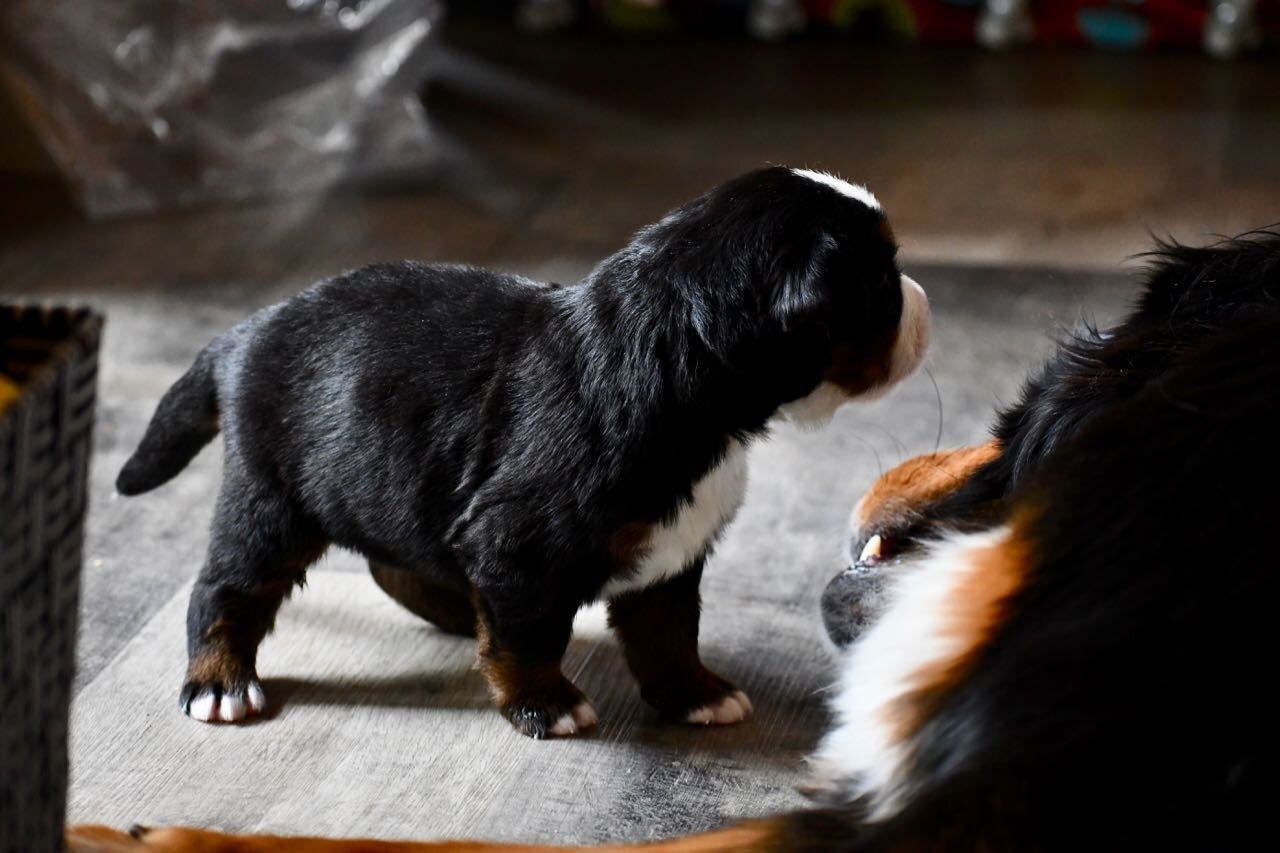Three weeks old. Amazing.
This is Mariposa with a toy that has been through multiple litters, including Suzanne’s. It makes noise when it is bumped, and that kind of novel sensory experience is what puppies need at this age.
But it is supported novel experience — it happens in the context of a safe, secure, and familiar place. The goal is confidence, and to develop that puppies (and humans) need new experiences but ones that can be mastered without fear and anxiety. Baby steps — or rather, Puppy Steps.
The Wildflowers are certainly gaining mastery of their bodies. Walking is confident and steady, and they can roll around at will — this is Clarkia.
After rolling, she chewed on her foot a bit — how cute is that?!
Clarkia is a good example of why puppy placement is a puzzle and hard to decide in advance. Puppy personalities are emerging, and I can tell you Clarkia deserves to be in a smart working home with someone who will appreciate her potential — this puppy will go far with the right person.
Daisy continues to keep her puppies clean, well fed, and happy. This kind of maternal attention is absolutely critical to development, and so we support and encourage it and that includes by supporting and encouraging extended and frequent nursing of puppies.
Some people start puppies on “solid food” at this age.
I remember a long-time breeder who once told me she weaned puppies at three weeks because she, “could feed them better.”
So so inaccurate.
Human parents used to be told to introduce solid foods early (six weeks!) — now the World Health Organization says human infants should be exclusively breast fed until six months old.
The next two photos are a sequence of Paintbrush and Larkspur.
We are growing in our understanding that gut microbiota is a key component in immune functioning; we need to care about this as we build and maintain healthy immune systems.
In a review of existing research on the topic of infant intestinal microbiome, Meropol & Edwards (2015) report that, “type of feeding, breast milk versus formula, has a large influence on microbiome composition (p. 230).
Breast milk has evolved to provide exactly what babies need — including what is needed by the baby’s microbiome.
Introduction to solid food changes the gut microbiome in humans and animals, and it is not without consequence; the practice of early weaning in piglets causes significant GI issues and prompts widespread antibiotic use in that industry (Gresse et al., 2017).
Early introduction to solid foods is linked to a variety of unfortunate long-term outcomes in humans, and so one has to wonder about the rush to replace optimal nutrition with sub-optimal.
One article I read about human breastfeeding discusses a social coercion of weaning theory (Stearns, 2011). Interesting! I think there is social pressure in weaning puppies as well — and likely just a lack of updated knowledge.
Clover and Clarkia
The Wildflowers — and their developing gut microbiome — will continue to benefit from being exclusively breastfed.
With all the evidence pointing to the importance of this, why would I do anything else?
This morning we added some new blooms to the Wildflowers’ lives — thank you to Marti for this fun-tastic gift.
Larkspur
The flowers crinkle and so offer wonderful and age-appropriate sensory experiences — and they are stinking cute!
Puppies love playing with each other — this is Sage and Mariposa.
Please have a healthy day — and take good care of your own gut microbiome!
EVENING: PHOTOS FROM THE DAY
I forgot to mention something this morning — first social tail wag! Larkspur greeted me this morning by wagging his tail — MY HEART! They are also running now — it is crazy how fast they change.
Mariposa and Buttercup
Paintbrush
Lupine
I think the photo below is hilarious — Clarkia is tipped over in a milk coma and Paintbrush just walked over the top of the nursing puppies…
Who need hair gel when your mom is free with her spit?!
The puppies are biting Daisy now - this is Mallow.
The play structure was out for about two hours today — this is Mallow again.
It is getting crowded!
Larkspur and Clarkia…
Mallow
Karma stopped in for a visit. She licked Larkspur for a bit…
…and all was great until Paintbrush grabbed her tail and got swatted. OOPS.
Larkspur assaulting one of the Bobs.
Three weeks is a wrap! Good night, Friends.
Work Cited
Meropol, Sharon B ; Edwards, A. (2015). Development of the infant intestinal microbiome: A bird's eye view of a complex process Birth Defects Research. Part C, Embryo Today, Reviews, Dec 2015, Vol.105(4), pp.228-239.
Gresse, R ; Chaucheyras-Durand, F ; Fleury, MA ; Van de Wiele, T ; Forano, E ; Blanquet-Diot, S. (2017). Gut Microbiota Dysbiosis in Postweaning Piglets: Understanding the Keys to Health. Trends In Microbiology, Oct, Vol.25(10), pp.851-873.






































































